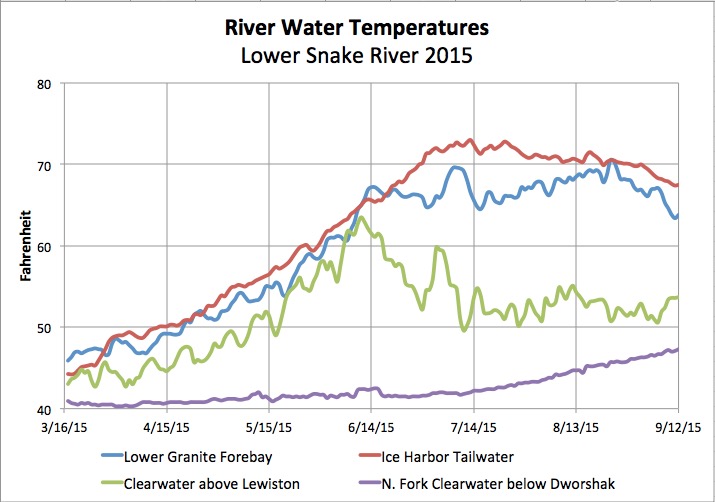forum
library
tutorial
contact

EPA says Federal Dams Raise
Water Temperature in Snake River
by Associated Press
Flathead Beacon, May 20, 2020
|
the film forum library tutorial contact |

|
EPA says Federal Dams Raise
by Associated Press
|
By slowing the flow and increasing the surface area exposed to the sun,
the dams cause the Snake River to increase as much as 5.7 degrees,
 LEWISTON, Idaho – An Environmental Protection Agency report provides details about how federal government dams in the Snake and Columbia river system raise summer water temperatures, hurting endangered salmon runs.
LEWISTON, Idaho – An Environmental Protection Agency report provides details about how federal government dams in the Snake and Columbia river system raise summer water temperatures, hurting endangered salmon runs.
The report made public Tuesday said dams on both rivers play a role in raising water temperatures above 68 degrees, which is the point at which the water becomes harmful to salmon and steelhead.
The Lewiston Tribune said the report also noted that the Snake River often exceeds temperature standards before it enters Washington from Idaho, as does the Columbia River when it enters Washington from Canada.
The report is likely to play a role in the long-simmering debate over the role dams play in the decline of threatened and endangered Snake River salmon and steelhead.
The dams generate electricity, allow cargo to be moved on river barges and provide irrigation water to farmers.
By slowing the flow and increasing the surface area exposed to the sun, the dams cause the Snake River to increase as much as 5.7 degrees, according to the report.
Temperatures higher than 68 degrees can cause adult fish to stop their migrations and swim around aimlessly like they are lost during their return from the ocean. When rivers warmed into the 70s in 2015 and stayed there for weeks, there were significant fish kills.
While there are other sources of rising temperatures in the river, the dams play the largest role, the report said.
Environmental groups hailed the report as a needed step toward lowering temperatures and improving conditions for salmon and steelhead.
Following the 2015 heat event that killed off sockeye, a coalition of river preservation groups including Columbia Riverkeeper, Snake River Waterkeeper and Idaho Rivers United went to court to force the EPA to finish writing the report that had been stalled for nearly two decades.
"We are pleased that it's done and identifies the hot water problems on the Columbia and Snake rivers," said Brett VandenHeuvel, executive director of Columbia Riverkeeper.
It will largely be up to the states to determine how water quality problems identified in the report should be addressed. VandenHeuvel said removing the lower Snake River dams or putting holes in them would help meet water quality standards as well as boost salmon and steelhead.
"The water temperatures in the Snake are so hot in the summer that I think dam removal is the best way to restore salmon and provide water cool enough for their survival," he said.
But Kurt Miller, executive director of Northwest River Partners, would prefer that regulators in Oregon and Washington re-examine their water quality standards.
"The states may have established water quality standards that are unattainable even if the lower Snake and mid-Columbia river dams were not in place," he said. "It would be unfair to penalize the communities that rely on hydropower for river temperatures way beyond their control."
Environmental groups have long called for four dams on the Snake River in eastern Washington to be removed to help salmon and steelhead migrate to the ocean and back. But the dams have plenty of supporters, including some members of Congress and business groups.
Related Sites:
Columbia and Lower Snake Rivers Temperature Total Maximum Daily Load by State of Washington Department of Ecology, 5/7/2020
Related Pages:
For First Time, Federal Dam Operators Must Make Water Temperature Control Plan by Mallory Gruben, The Daily News, 5/13/20
Columbia, Snake River Dam Operators Must Make Plan to Keep Waters Cold Enough for Salmon Survival by Jeremy P. Jacobs, E&E News, 3/30/20
Court Orders EPA to Write Temperature Control Plans for Columbia, Snake by George Plaven, Capital Press, 12/27/19
Federal Court Ruling Expected to Affect Salmon Conservation by Associated Press, Lewiston Tribune, 12/27/19
Federal Appeals Court Pins EPA with Responsibility for Snake, Columbia River Plan by Eric Barker, Lewiston Tribune, 12/21/19
Federal Appeals Court Orders EPA to Create Plan to Lower Water Temperatures on Columbia River by Evan Bush, Seattle Times, 12/20/19
Court says EPA Must Regulate River Temperatures for Fish by Jeremy P. Jacobs, E&E News, 12/20/19
'It's Just Not Working': Republican Slams Salmon Regime by Jeremy P. Jacobs, E&E News, 3/11/20
Snake River Dam Removal: Idaho Congressman Makes the Case to Save Salmon by Ben Long, Outdoor Life, 4/30/19
An Idaho Republican is Asking the Right Questions About Northwest Salmon by Tom France, Crosscut, 4/29/19
Leaders React to Dam Breaching Comments by Eric Barker, Lewiston Tribune, 4/27/19
Simpson Stops Short of Calling for Dam Removal to Save Salmon. But He Is Asking, 'What If?' by Rocky Barker, Idaho Statesman, 4/25/19
Congressman Mike Simpson says He's Determined to See Fish Runs Recovered in His Lifetime by Eric Barker, Lewiston Tribune, 4/25/19
'I Want Salmon Back in Idaho.' Simpson Seeks Bold Action After $16 Billion Spent on Recovery by Cynthia Sewell, Idaho Statesman, 4/23/19
learn more on topics covered in the film
see the video
read the script
learn the songs
discussion forum
